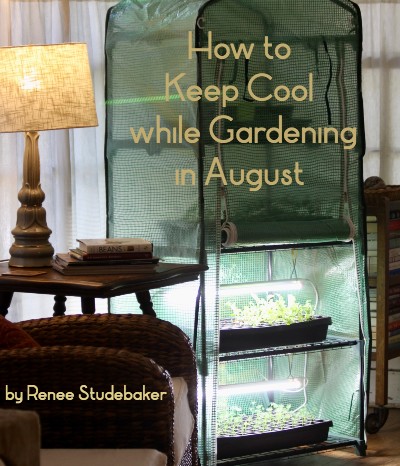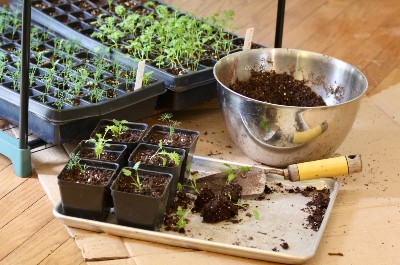 bringing nature, nurseries and gardeners together Aug. 20, 2021
|
|
Welcome to our 'dog-days-of-summer' special edition.

It’s August, so of course it’s too hot and too buggy to enjoy spending much time in the garden. A couple of mornings a week, I drench myself in herbal mosquito repellant and head outdoors for short bursts of weeding and watering. It’s not much fun.
My gardening fun happens when I go back indoors, where for the last few weeks I’ve been growing and repotting vegetable and herb seedlings in the middle of my living room floor.
While I work, I listen to music or sometimes an audiobook. The plants seem to appreciate the music and the air-conditioning just as much as I do. I admit though that I’ve felt a few twinges of guilt. Isn’t this cheating? Shouldn’t I be sweating?
Nah. I’ll be sweating again in late September when it’s time to prep the garden for the transplants. Until then, I’m enjoying every air-conditioned moment I can manage.
Gather supplies 1. Seed starting mix. I like ProMix with mycorrhizae, but you can also make a light, soilless mix with peat moss (or coir), perlite and vermiculite.
2. 50- or 72-cell seed starter tray. 3. Growing tray (to catch water and hold the seed tray). 4. A large mixing bowl or bucket, trowel and watering can. 5. Liquid fish emulsion (or other liquid fertilizer). 6. Potting soil. I use half Pro Mix and half compost, but premixed potting soils like Happy Frog or Fox Farm are also fine. 7. 4-inch pots and holding trays. 8. Cardboard or drop cloth. 9. Seeds. Make sure the cool weather seeds you choose have time between now and the average freeze date (usually the first week of December) to germinate, grow and mature. Or choose plants that tolerate some frost. Consult the seed package and A&M’s Vegetable Garden Planting Guide for recommended indoor and outdoor planting schedules. Plant seeds 1. Spread cardboard on floor and lay out supplies.
2. Fill bowl or bucket with seed starting mix, add water, about a cup at a time, and turn the mix lightly with a trowel until it’s moist enough to form a ball when squeezed. If it drips when squeezed, it’s too wet. Stir in more starting mix if you need to reduce the moisture level. 3. Fill seed compartments with the moist mix. Leave about a quarter inch of space at the top of each cell. Press lightly to remove any air pockets and add more mix if needed. 4. Place one seed in the middle of each cell. Then place a small clump of moist mix on top of each seed. Press lightly so the mix makes contact with the seed. Check seed packets for recommended seed depth and be careful not to bury the seeds too deep. 5. Place the planted seed tray into the holding tray. Water lightly. 6. Place the tray of seeds in an out of the way air-conditioned spot in your home. Most cool weather vegetables and herbs germinate best when soil temperatures are around 70 to 75 degrees Fahrenheit. That’s why our air-conditioned homes are ideal for fall seed starting. Sidenote: If you have a cat, you may need to take precautions to protect your seed starting tray. That’s why I decided to spring for a small indoor greenhouse. (see photo above) The plastic covering serves as a cat deterrent.
 cilantro seedlings cilantro seedlings
Add light, food and water
1. After the seeds germinate (5 to 12 days depending on seed type and the temperature in your home) they will immediately need full spectrum light, either from an indoor grow light or sunshine.
2. If you move your plants outdoors for light, you may want to try 40 percent shade cloth to keep them from baking in the heat. 0r try limiting exposure to morning sun only. 3. Watch your seedlings. If they get leggy, they need more light. 4. Check outdoor seedlings twice a day, early morning and late afternoon, to make sure they’re staying moist. Take care not to drown the roots. Pour off any water that collects. (Indoor seedlings under grow lights will need less water.) 5. If outdoor seedlings become leggy, they need more light. 6. When seedlings are a week old, start fertilizing lightly by adding liquid fertilizer at ¼ recommended strength to your watering can once or twice a week. Gradually increase the strength of the fertilizer as the plants grow and form true leaves.  Dill, mustard & cilantro in 4" pots. Bump seedlings into larger pots
1. After true leaves form, seedlings are ready to be transplanted into 4-inch pots of potting soil. This can be messy, but it’s still do-able indoors if you keep everything contained to cardboard or drop cloth.
2. Moisten soil in mixing bowl, then fill the pots. 3. Use your fingers to make a hole, approximately 2x2 inches, in each pot. 4. Carefully remove seedlings and tuck them into their new pots. 5. Water lightly to settle plants into new soil. Note: To remove seedlings, use a small spoon or a popsicle stick to gently scoop them out of their cells. Be careful not to tug on the stems. If they break, the plant may not recover. The cotyledons (the first leaves that appeared on the plant) are stronger, so if the root ball is loose and falls apart, gently pick the baby plant up by its top leaves and place it roots-first into the planting hole.
Add more light, food and water
1. If you’re using indoor grow lights, be sure to keep them adjusted so they’re suspended no more than 2 inches above plants. Lights positioned too high will produce leggy transplants.
2. If your transplants are outside, watch them closely so they don’t dry out in the heat. 3. Add a little liquid fertilizer to your watering can once a week. In early October, the seedlings should be ready to go into garden beds or outdoor containers. And I’ll be ready to venture outdoors again. ❦
Longtime Austin gardener and writer Renee Studebaker is a retired newspaper journalist who now teaches children how to grow and cook vegetables. (all photos above by Renee)
_________________________________________________
Support the Austin Garden! This newsletter relies on donations from readers. Please consider making a donation today. Many thanks ; - ) PayPal❦
|
 It's About Thyme Legacy Publications.
Contact newsletter editor Darrel Mayers with any ideas for articles or interesting links at internationalrain@yahoo.com (hitting 'reply' to this email won't work) |
|
|